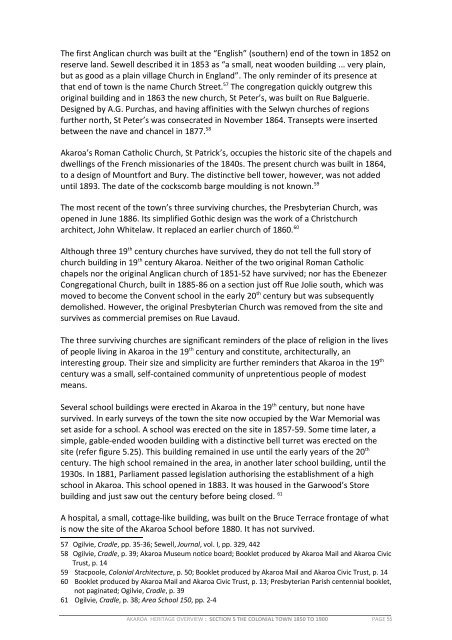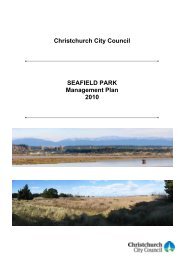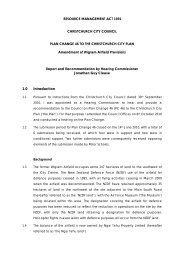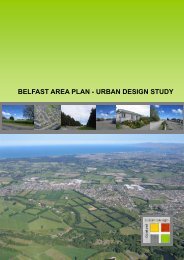Akaroa Historical Overview - Christchurch City Council
Akaroa Historical Overview - Christchurch City Council
Akaroa Historical Overview - Christchurch City Council
Create successful ePaper yourself
Turn your PDF publications into a flip-book with our unique Google optimized e-Paper software.
The first Anglican church was built at the “English” (southern) end of the town in 1852 on<br />
reserve land. Sewell described it in 1853 as “a small, neat wooden building ... very plain,<br />
but as good as a plain village Church in England”. The only reminder of its presence at<br />
that end of town is the name Church Street. 57 The congregation quickly outgrew this<br />
original building and in 1863 the new church, St Peter’s, was built on Rue Balguerie.<br />
Designed by A.G. Purchas, and having affinities with the Selwyn churches of regions<br />
further north, St Peter’s was consecrated in November 1864. Transepts were inserted<br />
between the nave and chancel in 1877. 58<br />
<strong>Akaroa</strong>’s Roman Catholic Church, St Patrick’s, occupies the historic site of the chapels and<br />
dwellings of the French missionaries of the 1840s. The present church was built in 1864,<br />
to a design of Mountfort and Bury. The distinctive bell tower, however, was not added<br />
until 1893. The date of the cockscomb barge moulding is not known. 59<br />
The most recent of the town’s three surviving churches, the Presbyterian Church, was<br />
opened in June 1886. Its simplified Gothic design was the work of a <strong>Christchurch</strong><br />
architect, John Whitelaw. It replaced an earlier church of 1860. 60<br />
Although three 19 th century churches have survived, they do not tell the full story of<br />
church building in 19 th century <strong>Akaroa</strong>. Neither of the two original Roman Catholic<br />
chapels nor the original Anglican church of 1851-52 have survived; nor has the Ebenezer<br />
Congregational Church, built in 1885-86 on a section just off Rue Jolie south, which was<br />
moved to become the Convent school in the early 20 th century but was subsequently<br />
demolished. However, the original Presbyterian Church was removed from the site and<br />
survives as commercial premises on Rue Lavaud.<br />
The three surviving churches are significant reminders of the place of religion in the lives<br />
of people living in <strong>Akaroa</strong> in the 19 th century and constitute, architecturally, an<br />
interesting group. Their size and simplicity are further reminders that <strong>Akaroa</strong> in the 19 th<br />
century was a small, self-contained community of unpretentious people of modest<br />
means.<br />
Several school buildings were erected in <strong>Akaroa</strong> in the 19 th century, but none have<br />
survived. In early surveys of the town the site now occupied by the War Memorial was<br />
set aside for a school. A school was erected on the site in 1857-59. Some time later, a<br />
simple, gable-ended wooden building with a distinctive bell turret was erected on the<br />
site (refer figure 5.25). This building remained in use until the early years of the 20 th<br />
century. The high school remained in the area, in another later school building, until the<br />
1930s. In 1881, Parliament passed legislation authorising the establishment of a high<br />
school in <strong>Akaroa</strong>. This school opened in 1883. It was housed in the Garwood’s Store<br />
building and just saw out the century before being closed. 61<br />
A hospital, a small, cottage-like building, was built on the Bruce Terrace frontage of what<br />
is now the site of the <strong>Akaroa</strong> School before 1880. It has not survived.<br />
57 Ogilvie, Cradle, pp. 35-36; Sewell, Journal, vol. I, pp. 329, 442<br />
58 Ogilvie, Cradle, p. 39; <strong>Akaroa</strong> Museum notice board; Booklet produced by <strong>Akaroa</strong> Mail and <strong>Akaroa</strong> Civic<br />
Trust, p. 14<br />
59 Stacpoole, Colonial Architecture, p. 50; Booklet produced by <strong>Akaroa</strong> Mail and <strong>Akaroa</strong> Civic Trust, p. 14<br />
60 Booklet produced by <strong>Akaroa</strong> Mail and <strong>Akaroa</strong> Civic Trust, p. 13; Presbyterian Parish centennial booklet,<br />
not paginated; Ogilvie, Cradle, p. 39<br />
61 Ogilvie, Cradle, p. 38; Area School 150, pp. 2-4<br />
AKAROA HERITAGE OVERVIEW : SECTION 5 THE COLONIAL TOWN 1850 TO 1900 PAGE 55
















